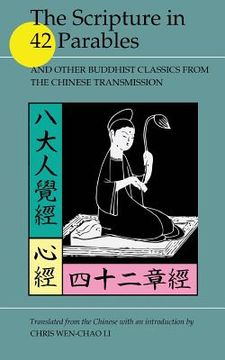The Scripture in 42 Parables: and Other Buddhist Classics from the Chinese Transmission (en Inglés)
Reseña del libro "The Scripture in 42 Parables: and Other Buddhist Classics from the Chinese Transmission (en Inglés)"
Collected in this volume are three of the most widely-disseminated shorter canonical texts of East Asian buddhism, namely The Scripture in Forty-Two Parables, The Eight Revelations from the Realm of Higher Beings, and The Heart of the Virtue of Wisdom, presented in a new domesticated translation based on a literary reading of the Chinese source texts. The Scripture in Forty-Two Parables (a.k.a. The Sutra in Forty-Two Sections, The Sutra in Forty-Two Parts, or The Sutra of Forty-Two Chapters), dating to A.D. 67, is believed by many to be the earliest work of buddhism to be introduced from India into China, and as such is afforded special status in Chinese buddhism and folklore. The scripture is divided into forty-two sections, consisting for the most part of direct quotes from the Buddha addressing an audience of entry-level initiates. In the scripture, explanation of buddhist concepts is done in colloquial language, and vivid metaphors are created to relate core beliefs to such daily concerns as family, marriage, charity, wealth, ambition, temptation, and sex. References to The Scripture in Forty-Two Parables appear in such Chinese historical records as the Annals of the Later Han, and play a central role in the martial arts novel The Deer and the Cauldron by cult author Louis Cha. The Scripture in Forty-Two Parables is regarded as one of three canonical legacy teachings of the Buddha in the Zen buddhist traditions of China, Japan and Korea. The Eight Revelations from the Realm of Higher Beings (a.k.a., The.Sutra of the Eight Realizations of Great Beings or The Eight Great Awakenings Sutra) is another of the Buddha's three legacy teachings of the East Asian Zen tradition, similarly directed at an audience of initiates and written in the vernacular style characteristic of early buddhist transmissions to China. The Eight Revelations from the Realm of Higher Beings takes as its subject the impermanence of the psycho-physical world and the illusory nature of sensory experiences, pointing out that attachment and desire lie at the heart of these illusions, and, in the latter half of the scripture, goes on to prescribe methods to see past these illusions. With a similar emphasis on the illusory nature of reality is the third text in this series, The Heart of the Virtue of Wisdom, better known as the Prajnaparamita Heart Sutra (Prajnaparamita. Hrdaya Sutra), arguably the most revered and most commonly chanted scripture in all of the world's buddhist traditions. In its brief length, the Heart Sutra touches upon virtually all of the core concepts of buddhist philosophy, including the five skandhas, the twelve ayatanas, the eighteen dhatus, and the twelve nidanas, along with dukkha and the Four Noble Truths, explaining eventually that all such dogmatic teachings, along with the psycho-physical world we live in and the sensory stimuli we experience, are illusory in nature, and must be understood as such before one can move on to a higher level of understanding (anuttara samyak-sambodhi) and approach the blissful state of nirvana. The sutra ends atypically with a transliterated dharani mnemonic for chanting, a verse which, in many regional buddhist traditions, is believed to be imbued with spiritual or transcendental powers. The method of translation adopted this volume differs somewhat from that found in most existing buddhist translations into English. In this collection, the Chinese originals are treated as literary in nature, and a structuralist reading is applied to arrive at the meaning of the text. A domesticating strategy is then used to render the cultural elements of the narrative in an attempt to create dynamic equivalence between the experiences of source and target language audiences.

